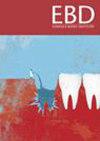The influence of the gingival phenotype on implant survival rate and clinical parameters: a systematic review
IF 2.3
Q3 Dentistry
引用次数: 0
Abstract
The goal of this systematic review was to verify whether the gingival phenotype (thick or thin) could impact the dental implant survival rate by affecting the marginal bone. The search was carried out on PubMed/MedLine, PubMed Central, and B-On databases. The research question was: “Does gingival phenotype positively or negatively influence marginal bone loss around dental implants?” The inclusion criteria were: any clinical trial/study, comparative study, prospective or retrospective articles, systematic review that addressed at least a 1-year follow-up with an assessment of the marginal bone loss (MBL) around dental implants, articles that reported the gingival phenotype (thin or thick) and were published in the last 13 years. The exclusion criteria were narrative or other reviews, letters to the editor, and commentaries. Data extraction included the author’s name, year of publication, type of study, sample size, number of implants, method used, and outcomes presented. The extracted data was summarized and presented in the results section. Critical Appraisal tool in JBI Systematic Reviews was used to determine the possibility of bias. A total of 62 articles were found, but eight articles were relevant to compose this study. After deep evaluation, it was possible to observe the implant success rate for both gingival phenotypes, thin and thick, was greater than 91% within a follow-up of up to 5 years. Therefore, it is unclear whether the thickness of the gingival tissue surrounding the implant can directly influence the marginal bone level. The gingival phenotype may be indirectly involved in the survival rate of dental implants, as it can be a risk factor for peri-implantitis, leading to marginal bone loss beyond what is expected. The thin gingival phenotype is one of the main risk factors for additional bone loss. It is crucial to know how to preserve the healthy condition. Within the results found, the gingival phenotype is indirectly related to implant survival rate and clinical parameters, which were respectively high and non-conclusive. Therefore, a higher risk of peri-implantitis is suggested when a thin phenotype is present.

牙龈表型对种植体存活率和临床参数的影响:一项系统综述。
目的:本系统综述的目的是验证牙龈表型(厚或薄)是否会通过影响边缘骨来影响种植体的存活率。方法:检索PubMed/MedLine、PubMed Central和B-On数据库。研究的问题是:“牙龈表型对种植牙周围的边缘骨质流失是积极的还是消极的?”纳入标准为:任何临床试验/研究、比较研究、前瞻性或回顾性文章、涉及至少1年随访并评估种植体周围边缘骨质流失(MBL)的系统评价、报道牙龈表型(薄或厚)并在过去13年内发表的文章。排除标准是叙述或其他评论、给编辑的信件和评论。数据提取包括作者姓名、发表年份、研究类型、样本量、植入物数量、使用的方法和呈现的结果。提取的数据在结果部分进行了总结和展示。使用JBI系统评价中的关键评价工具来确定偏倚的可能性。结果:共检索到62篇文献,其中8篇与本研究相关。经过深入评估,可以观察到,在长达5年的随访中,无论是薄的还是厚的牙龈表型,种植成功率都大于91%。因此,种植体周围牙龈组织的厚度是否会直接影响边缘骨水平尚不清楚。牙龈表型可能间接影响种植体的存活率,因为它可能是种植体周围炎的危险因素,导致超出预期的边缘骨质流失。讨论:薄的牙龈表型是增加骨质流失的主要危险因素之一。知道如何保持健康的状态是至关重要的。结论:在所发现的结果中,牙龈表型与种植体存活率和临床参数间接相关,分别为高和非结论性。因此,当存在薄表型时,植入物周围炎的风险较高。
本文章由计算机程序翻译,如有差异,请以英文原文为准。
求助全文
约1分钟内获得全文
求助全文
来源期刊

Evidence-based dentistry
Dentistry-Dentistry (all)
CiteScore
2.50
自引率
0.00%
发文量
77
期刊介绍:
Evidence-Based Dentistry delivers the best available evidence on the latest developments in oral health. We evaluate the evidence and provide guidance concerning the value of the author''s conclusions. We keep dentistry up to date with new approaches, exploring a wide range of the latest developments through an accessible expert commentary. Original papers and relevant publications are condensed into digestible summaries, drawing attention to the current methods and findings. We are a central resource for the most cutting edge and relevant issues concerning the evidence-based approach in dentistry today. Evidence-Based Dentistry is published by Springer Nature on behalf of the British Dental Association.
 求助内容:
求助内容: 应助结果提醒方式:
应助结果提醒方式:


